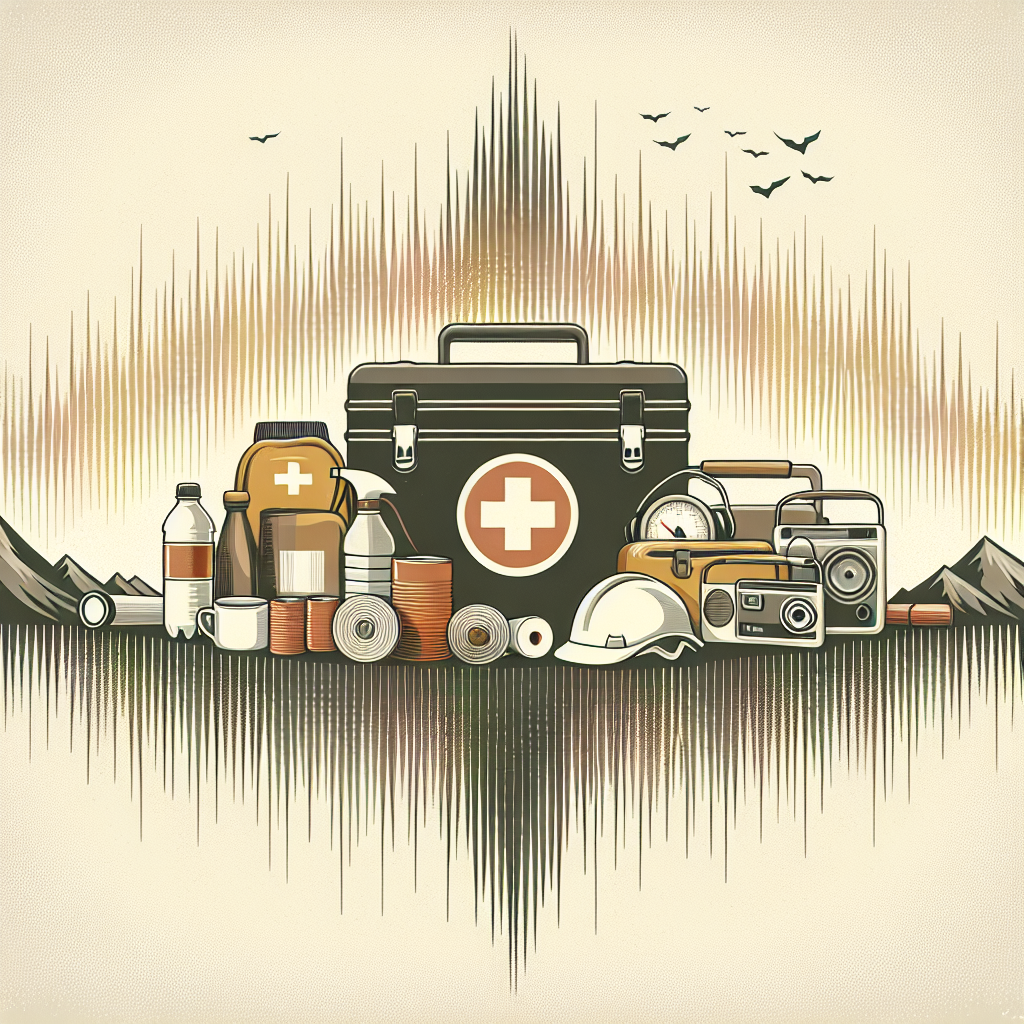In the event of an earthquake, it is crucial to be prepared and have a clear plan in place to ensure your safety and well-being. From creating an emergency kit to identifying safe spots in your home, this article will guide you through the essential steps of planning for earthquake survival. By taking proactive measures and staying informed, you can confidently navigate any seismic event and minimize potential risks. So, let’s get started on this important journey towards safeguarding yourself and your loved ones in the face of an earthquake.

Recognizing earthquake risks
Earthquakes are natural disasters that can strike with little to no warning, causing significant damage and disruption to communities. By understanding the causes and characteristics of earthquakes, you can better recognize the risks and take necessary precautions. Earthquakes occur when there is a sudden release of energy in the Earth’s crust, resulting in seismic waves that shake the ground. These seismic waves can cause buildings to collapse, landslides, and other secondary hazards.
To identify high-risk areas, it is important to research and consider historical seismic activity in your region. Fault lines, regions near tectonic plate boundaries, or areas with a history of strong earthquakes are particularly susceptible. Government agencies and geological surveys often provide information on earthquake hazards and risk zones. By staying informed about local seismic activity, you can better prepare for the possibility of an earthquake.
Creating a disaster preparedness plan
Having a well-thought-out disaster preparedness plan is crucial for your safety and the safety of your loved ones during an earthquake. Start by assembling an emergency kit that includes essential items such as non-perishable food, water, flashlights, batteries, first aid supplies, and important documents. This kit should be easily accessible and regularly updated.
In addition to the emergency kit, develop a communication plan with your family and friends. Establish a designated contact person who can relay information and relay messages in case of communication disruptions. Plan a safe meeting place where everyone can gather after the earthquake. Choose a location away from buildings, power lines, and other potential hazards.
Securing your home
Your home is where you spend a significant amount of time, so it is crucial to take steps to secure it against earthquake damage. Reinforce structures such as walls, foundations, and chimneys to make them more resistant to shaking. Attach heavy furniture and appliances to the walls or floor to prevent them from toppling over during an earthquake. Consider installing safety devices such as latches on cabinets and quake-sensitive shut-off valves for gas and water utilities.
Preparing for immediate response
When an earthquake strikes, immediate response actions can potentially save lives and reduce injuries. Remember the “Drop, Cover, and Hold On” technique, which involves dropping to the ground, taking cover under a sturdy piece of furniture, and holding on until the shaking stops. This position protects you from falling objects and provides some protection from structural collapse.
Identify safe zones within your home or workplace where you can seek shelter during an earthquake. These areas should be away from windows, heavy furniture, and potential hazards. Familiarize yourself with the layout of your building and determine escape routes in case of emergencies. Additionally, be prepared for aftershocks, which are smaller earthquakes that often follow a larger one. Aftershocks can be just as dangerous, so stay vigilant and take appropriate safety precautions.

Ensuring water and food supply
During and after an earthquake, access to clean water and an adequate food supply may be disrupted. Stock up on non-perishable food items that can sustain you and your family for several days or even weeks. Canned goods, dry foods, and energy bars are good options. Don’t forget to include a manual can opener in your emergency kit.
In addition to food, ensure you have an ample supply of drinking water. Store at least one gallon of water per person per day for a minimum of three days. If tap water becomes contaminated or unavailable, you can purify water using methods such as boiling, disinfection tablets, or portable water filters. Regularly check and rotate your supplies to ensure they remain fresh and usable.
Understanding evacuation procedures
In some situations, depending on the severity of the earthquake or the proximity to high-risk areas, evacuation may be necessary. Research and familiarize yourself with local evacuation routes and shelters in advance. Determine primary and secondary routes to a safe location and identify any potential obstacles or hazards along the way.
Prepare a go-bag or emergency backpack containing essential items that you can easily grab in case of evacuation. This bag should include important documents, medications, spare clothing, food, water, and personal hygiene items. Keep the go-bag in a designated location that is easily accessible to all family members.
Also, consider determining evacuation triggers. These may include certain ground motions, alarms, or official evacuation orders. By being prepared and aware of these triggers, you can act quickly and effectively during a time-sensitive situation.

Preparing physically and mentally
Being physically and mentally prepared can greatly increase your ability to respond and recover after an earthquake. Regularly engage in activities that strengthen your physical fitness, such as exercise and stretching. This will help improve your overall endurance, strength, and flexibility, making it easier to navigate through potential obstacles and assist others if needed.
Attending CPR and first aid courses is highly recommended. These skills can be invaluable in providing immediate medical assistance to yourself and others until professional help arrives. Learning to recognize and manage stress and anxiety is also essential since earthquakes can be traumatic events. Practice relaxation techniques and seek support from loved ones or professional resources to help cope with the emotional impact.
Caring for vulnerable individuals
When preparing for earthquake survival, it is crucial to consider the specific needs of vulnerable individuals in your household or community. Plan for the care of children and infants by having an adequate supply of diapers, formula, medications, and comforting items. Educate older children about earthquake safety measures and discuss emergency plans so they know what to do during an earthquake.
Address the needs of elderly or disabled individuals by ensuring they have necessary medications, medical equipment, supportive devices, and access to care. Include them in discussions about emergency plans and assign someone to check on their well-being during and after an earthquake.
If you have pets, make arrangements for their safety. Keep a supply of pet food, water, medications, and comfort items. Identify pet-friendly shelters or boarding facilities in case you need to evacuate. Have a collar with identification tags and a carrier or leash readily available to secure your pet during an emergency.

Recovering after an earthquake
After an earthquake, the safety of your immediate surroundings should be your top priority. Assess the area for any immediate hazards such as downed power lines, gas leaks, or structural damage. If you smell gas or suspect a leak, evacuate the area immediately and contact emergency services.
Seek medical attention for yourself or others who may be injured. Even seemingly minor injuries, if left untreated, can escalate, so it is crucial to receive proper medical care as soon as possible. Contact local authorities or emergency services to report any emergency situations or individuals who may need assistance.
Once you have ensured your immediate safety and addressed any medical concerns, evaluate the structural damage to your property. Assess the stability of your home, inspecting for cracks, bulges, or other signs of structural weakness. If you suspect damage, contact a qualified professional or a structural engineer to conduct a thorough inspection and make necessary repairs.
Engaging with the community
Your community can be a valuable resource in earthquake preparedness and recovery efforts. Consider joining local response and assistance groups, such as Community Emergency Response Teams (CERT), to actively contribute to disaster preparedness and response initiatives. These groups provide training and knowledge to individuals willing to help during emergencies.
Participate in drills and simulations organized by local authorities or community organizations. These exercises simulate real-time emergency situations and allow you to practice your earthquake preparedness and response skills in a controlled environment. By actively participating, you can identify areas for improvement and gain confidence in your ability to effectively respond to earthquakes.
Even when not faced with an immediate threat, spreading awareness and educating others about earthquake preparedness is crucial. Share your knowledge and experiences with friends, family, neighbors, and colleagues. Encourage them to create their own disaster preparedness plans and provide them with resources and information to help them get started.
In conclusion, recognizing earthquake risks, creating a disaster preparedness plan, securing your home, preparing for immediate response, ensuring water and food supply, understanding evacuation procedures, preparing physically and mentally, caring for vulnerable individuals, recovering after an earthquake, and engaging with the community are all important steps to take in order to increase your chances of surviving and recovering from an earthquake. By implementing these measures and staying alert and informed, you can be better prepared to face this natural disaster and protect yourself and your loved ones.




